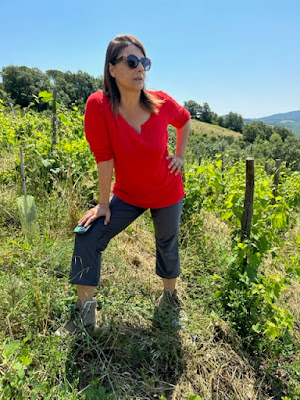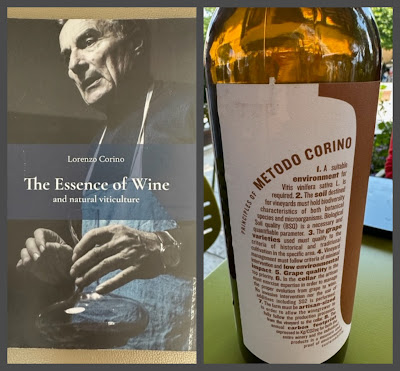 |
| Antonella Minuli of Fattoria La Maliosa |
La Maliosa, which translates to 'the sorceress' (per Google Translate) is a name that Antonella chose for her winery, but she based it on what she describes as the magical beauty of Southern Tuscany. Antonella moved to this area in the 1990s where she managed the Terme di Saturnia Roman spa and golf course. During her 10 years there she explored the rolling hills surrounding these ancient Roman thermal springs, which are a major tourist attraction just a couple hours north of Rome, and began to envision starting a sustainable agriculture project in the area, not necessarily vineyards. Over the course of the next few years, she purchased a series of properties totaling 70 hectares (173 acres), which not surprisingly were just right for grape vines and olive trees. However, she realized that more traditional Tuscans did not 'get' her and thought she was a bit crazy with her ideas about sustainable agriculture. In 2012 a friend introduced her to Piedmont-based Lorenzo Corino, an expert in sustainable viticulture, and it was a match made in wine heaven!
 |
'The Essence of Wine" by Lorenzo Corino; each bottle of La Malioa wine features the principles of Metodo Corino |
- The environment must be suitable for vitis vinifera (wine grapevines)
- The soil must hold biodiversity for both botanicals (flowers and grasses) and microorganisms (insects)
- Grape varieties must be 'historical' and 'traditional'*
- Minimal intervention in vine management
- Grape quality is the top priority
- In the cellar, no invasive intervention or additives can be used
- The farm must be 'artisan-sized'
- Carbon footprint must be measured as proof of environmental sustainability
Fattoria La Maliosa: Beyond Wine Tourism
Fattoria La Maliosa, on first glance, is not your typical tourist winery. It is, however, possibly the future of tourism, and therein lies its magic. It combines food, wine, olive oil, and 'experiential' accommodations, all in the place where everything is grown and made. Fattoria La Maliosa is reachable via a pothole-filled and bumpy dirt road, which on my visit challenged the undercarriage of my rental car! The torrential spring-summer rains in Tuscany had wreaked havoc on these roads. The main winery building is a restored yet still rustic 19th century farmhouse. Quite plain, but functional, this building serves as the current wine cellar on the ground floor (former animal stalls), and a tasting room and office (former living quarters with the original large open fireplace) on the top floor. Using her savvy business acumen, Antonelli secured European Union funds to help finance the construction of a brand-new cellar, which had just broken ground in early spring 2023, but was delayed due to the rains. Antonella also used EU funding to build a solar farm on one of her hillsides, providing clean energy for the winery.
 |
| Enjoying the view from the Big Bench |
La Maliosa offers picnic baskets for visitors, for a fee, and has designated areas throughout the vineyards to enjoy the goodies, including wine, charcuterie, cheese, bread, and, of course, a bottle of wine. These beautiful and private areas are ideal for romantic getaways, and the proximity to Rome allows weekenders to take advantage. Antonella says that 90% of her customers for such experiences are millennials and GenZers, not surprisingly. The Rome proximity is key to much of the economy of Southern Tuscany, which is one of the least densely populated regions in all of Italy. Tourism is their lifeblood, and Antonella knows it and provides much needed and wanted services.
One of Antonella's goals with her winery is to employee local young women to train them in the hospitality field. She and her employees taste her wines as she's making them, and help her make decisions during the winemaking process. Employees also conduct tastings with winery guests and help with marketing and food preparation.
Happy Wild Vineyards and Olive Groves
Near the Big Bench we entered some of the wildest looking vineyards I've ever seen in my life. There was so much growth of things other than grape vines that it was actually hard to spot the vines amidst them, much less the vineyard worker in the field below us, and it was a bit treacherous to step through this gorgeous underbrush. Wildflowers and grasses of many varieties were happily (yes, they looked happy!) growing alongside the vines. This was my first look at the biodiversity of La Maliosa vineyards, and I was captivated. Antonella explained her belief that vines are just one part of the biodiversity of a healthy vineyard, and that each and every form of plant life has a role to play in keeping the earth healthy.
 |
Don't expect pristine, manicured vines at Fattoria La Maliosa, but do expect happy healthy vines. |
Unique Vineyard Accommodations
StarsBox is another unique aspect of the La Maliosa experience. These are tiny cabins, or 'nests,' which are situated on hilltops on the vineyard providing stunning vistas during the day, and amazing star-gazing at night. They feature bedding for two people to sleep comfortably, and the tops of the tent-shaped structures have two panels that open up to the sky. La Maliosa has six StarsBox structures throughout the property, and they have proven to be quite popular, with most booked well in advance. The experience at a winery "has to be real" says Antonella, and tasting wine and other products of the land in nature, under the sun or the stars, provides that. While I have yet to experience a StarsBox, it's definitely on my bucket list.

StarsBox accommodations provide visitors with a unique vineyard experience.
In addition to running a winery, Antonella has opened a restaurant in a charming old building that she purchased in the village of Saturnia on the Piazza Vittorio Veneto. Called Saturnalia Wine Bar, the lovely place has delicious local cuisine and, of course, serves La Maliosa wines. We drank the 2021 UNI White Tuscany orange wine, which was recently awarded a Bronze medal at the 2023 Gaia Wine Challenge. The chef is a local woman, and one of the employees is a refugee from Ukraine. In fact, the building is currently housing eight refugees from Ukraine, who are residing in the apartments above the restaurant. Another of the refugees, Zorina Getman, is an accomplished watercolor artist who has been commissioned by Antonella to create artwork of various views around her winery and vineyards (see her artwork here.) Antonella's husband Fabrizio, who did the branding for La Maliosa, has done two missions to Ukraine. The couple has thus far hosted 16 refugees.

Watercolor paintings of La Maliosa from Ukrainian artist Zorina Getman
The Challenges of 2023
 |
| Hail damage on vines |
The wet conditions helped to point out the benefits of the healthy cover crops that La Maliosa has in place. Standing on the hay between the vines, which La Maliosa grows and harvests at significant expense, the vineyards were passable, whereas the areas where there was no hay and/or grassy cover crop were deep mud. The cover crops soak up the moisture in wet weather and hold in the moisture when the sun is blazing down, which it usually does in summers in Southern Tuscany.
The rains in Southern Tuscany in the first half of 2023 were torrential (as they were in Abruzzo and the Veneto), and well above normal. On the day I visited La Maliosa, Antonella said it was the first day in a month and a half when it did not rain. The rain not only created difficult conditions in the vineyards, but it also held up construction for 90 days on the new cellar. Antonella updated me in mid-July to say that the construction was back on track, and the last few weeks had been rain-free.
La Maliosa vines on the opposite side of the Fiora River, which is also a dividing line between clay soil on the side of the winery and volcanic soils on the other, were not affected by the hail, and those vines were growing according to plan. "Isn't it beautiful," Antonella said of one of her 2 hectare (about 5 acre) vineyards on the volcanic side of her property. "It's full of complexity." This complexity is achieved through a set process that requires patience. The initial step is planting the vines, and year one is all about revitalizing the soils. Nothing is done to the vineyard for the next two years, however this is when the biodiversity begins to happen, which is evident in the flowers, grasses and microorganisms visible amongst the vines.
Tasting La Maliosa Wines
My visit to La Maliosa culminated with a wine tasting. The wines are all 'natural,' and they are award winning. The grapes are grown in sustainable, organic, and biodynamic conditions, however the biodynamic portion is slightly different than Demeter in that it's 'vegetal closed cycle agriculture,' with zero animal products, such as cow horns. Hence, La Maliosa wines are truly vegan-friendly. Everything is bottled on site at the winery, and labels, which are applied by hand, are uniquely informational. They lay out the eight basic principles of the 'Metodo Corino' (see image above), thereby creating a dinner table conversation piece. The bottles weigh just 360 grams, the lowest possible weight for a usable wine bottle, which is a reduction by about half the carbon footprint of a standard 750ml bottle.
Four La Maliosa wines tasting during the summer of 2023 included the following:
This orange wine is a blend of Trebbiano Toscana and Procanico sees three weeks of skin contact, and ferments in stainless steel tanks. After fermentation the wine goes to big barrels for 6 months, then back to stainless steel for 90 days, and is then bottled. The wine pairs with pastas, cheeses, white meat, fish, and sautéed mushrooms. You can smell the vineyard in this wine, with mint, flowers, and green herbs flowing from the glass. This was delicious on the day I tasted it, I consider this the best orange wine I've ever tasted.
Note: During my visit to La Maliosa, Antonella learned that Vinepair had named La Maliosa 'Saturnia' Bianco 2020 one of the best orange wines for 2023.
2019 Toscana Rosso IGT
This is a blend of Ciliegiolo, Sangiovese, and Grenache, grown in clay soil. It has notes of peppery spices and baked cherry, with integrated tannins (note that it takes a couple of years for this to happen).
Made from 100% Ciliegiolo, which has to be picked at the right time to keep its acidity. The name means 'little cherry' in Italian, and the taste is close to Barbera, with notes of cherry tobacco.
This wine is 100% Cannonau (Grenache), and is spicy, with strong tannins. It has a lot of substance on the palate and pairs with lamb or beef.
I thoroughly enjoyed each and every taste of La Maliosa wines, and I feel inspired to delve further into sustainable and thoughtful wines. Select La Maliosa wines and olive oils are available in the US. Visit VeroVinoGusto.com.
Final Thoughts
In addition to all of the above, Antonella Minuli of Fattoria La Maliosa has set her sights on the future, in a way that benefits not just herself, but her employees, and Southern Tuscany in general. In addition to the new cellar under construction, projects in the work include the refurbishing of various old farm buildings on her property that have lain vacant for years (see photos below), which will allow more visitors to La Maliosa.
I'd like to experience more of this beautiful property, as well as Southern Tuscany in general. It's a gorgeous land, with dozens of picturesque hilltop villages, offering great restaurants, friendly people, ancient sites to explore, and loads of interesting history. Below are some more gorgeous vineyard shots from Fattoria La Maliosa.
.jpg) |
Until next time,
Ciao & Grazie mille!
